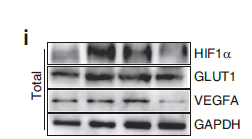
主要信息
Target
CRSP130
Host Species
Rabbit
Reactivity
Human, Mouse, Rat
Applications
WB, IHC, IF, ELISA
MW
150kD (Observed)
Conjugate/Modification
Unmodified
货号: YT1120
规格
价格
货期
数量
200μL
¥3,780.00
现货
0
100μL
¥2,300.00
现货
0
40μL
¥960.00
现货
0
加入购物车


已收藏


收藏
详细信息
推荐稀释比
WB 1:500-1:2000; IHC 1:100-1:300; IF 1:200-1:1000; ELISA 1:5000; Not yet tested in other applications.
组成
Liquid in PBS containing 50% glycerol, 0.5% BSA and 0.02% sodium azide.
特异性
CRSP130 Polyclonal Antibody detects endogenous levels of CRSP130 protein.
纯化工艺
The antibody was affinity-purified from rabbit antiserum by affinity-chromatography using epitope-specific immunogen.
储存
-15°C to -25°C/1 year(Do not lower than -25°C)
浓度
1 mg/ml
实测条带
150kD
修饰
Unmodified
克隆性
Polyclonal
同种型
IgG
相关产品
抗原&靶点信息
免疫原:
The antiserum was produced against synthesized peptide derived from human MED23. AA range:1-50
展开内容
特异性:
CRSP130 Polyclonal Antibody detects endogenous levels of CRSP130 protein.
展开内容
基因名称:
MED23
展开内容
蛋白名称:
Mediator of RNA polymerase II transcription subunit 23
展开内容
别名:
MED23 ;
ARC130 ;
CRSP3 ;
DRIP130 ;
KIAA1216 ;
SUR2 ;
Mediator of RNA polymerase II transcription subunit 23 ;
Activator-recruited cofactor 130 kDa component ;
ARC130 ;
Cofactor required for Sp1 transcriptional activation subunit 3 ;
CRSP complex subu
ARC130 ;
CRSP3 ;
DRIP130 ;
KIAA1216 ;
SUR2 ;
Mediator of RNA polymerase II transcription subunit 23 ;
Activator-recruited cofactor 130 kDa component ;
ARC130 ;
Cofactor required for Sp1 transcriptional activation subunit 3 ;
CRSP complex subu
展开内容
背景:
The activation of gene transcription is a multistep process that is triggered by factors that recognize transcriptional enhancer sites in DNA. These factors work with co-activators to direct transcriptional initiation by the RNA polymerase II apparatus. The protein encoded by this gene is a subunit of the CRSP (cofactor required for SP1 activation) complex, which, along with TFIID, is required for efficient activation by SP1. This protein is also a component of other multisubunit complexes e.g. thyroid hormone receptor-(TR-) associated proteins which interact with TR and facilitate TR function on DNA templates in conjunction with initiation factors and cofactors. This protein also acts as a metastasis suppressor. Several alternatively spliced transcript variants encoding different isoforms have been described for this gene. [provided by RefSeq, Jul 2012],
展开内容
功能:
Alternative products:Experimental confirmation may be lacking for some isoforms,Function:Required for transcriptional activation subsequent to the assembly of the preinitiation complex (By similarity). Component of the Mediator complex, a coactivator involved in the regulated transcription of nearly all RNA polymerase II-dependent genes. Mediator functions as a bridge to convey information from gene-specific regulatory proteins to the basal RNA polymerase II transcription machinery. Mediator is recruited to promoters by direct interactions with regulatory proteins and serves as a scaffold for the assembly of a functional preinitiation complex with RNA polymerase II and the general transcription factors. Required for transcriptional activation by adenovirus E1A protein. Required for ELK1-dependent transcriptional activation in response to activated Ras signaling.,similarity:Belongs to the Mediator complex subunit 23 family.,subunit:Interacts with ELK1 (By similarity). Component of the Mediator complex, which is composed of MED1, MED4, MED6, MED7, MED8, MED9, MED10, MED11, MED12, MED13, MED13L, MED14, MED15, MED16, MED17, MED18, MED19, MED20, MED21, MED22, MED23, MED24, MED25, MED26, MED27, MED29, MED30, MED31, CCNC, CDK8 and CDC2L6/CDK11. The MED12, MED13, CCNC and CDK8 subunits form a distinct module termed the CDK8 module. Mediator containing the CDK8 module is less active than Mediator lacking this module in supporting transcriptional activation. Individual preparations of the Mediator complex lacking one or more distinct subunits have been variously termed ARC, CRSP, DRIP, PC2, SMCC and TRAP. Interacts with CEBPB, CTNNB1, and GLI3. Interacts with the adenovirus E1A protein.,
展开内容
细胞定位:
Nucleus .
展开内容
组织表达:
Brain,Cervix carcinoma,Placenta,Prostate,Testis,
展开内容
文献引用({{totalcount}})
货号: YT1120
规格
价格
货期
数量
200μL
¥3,780.00
现货
0
100μL
¥2,300.00
现货
0
40μL
¥960.00
现货
0
加入购物车


已收藏


收藏
Recently Viewed Products
Clear allToggle night Mode
{{pinfoXq.title || ''}}
Catalog: {{pinfoXq.catalog || ''}}
Filter:
All
{{item.name}}
{{pinfo.title}}
-{{pinfo.catalog}}
主要信息
Target
{{pinfo.target}}
Reactivity
{{pinfo.react}}
Applications
{{pinfo.applicat}}
Conjugate/Modification
{{pinfo.coupling}}/{{pinfo.modific}}
MW (kDa)
{{pinfo.mwcalc}}
Host Species
{{pinfo.hostspec}}
Isotype
{{pinfo.isotype}}
产品 {{index}}/{{pcount}}
上一个产品
下一个产品
{{pvTitle}}
滚轮缩放图片
{{pvDescr}}





















